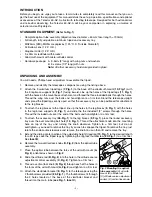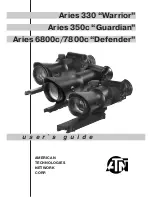
– 6 –
11. Insert the diagonal mirror (
13, Fig. 1
) into the focuser drawtube (
15, Fig. 1
) and the MA 25mm
eyepiece (
1, Fig. 1
) into the diagonal mirror. Tighten the respective thumbscrews to a firm feel.
12. The telescope is now completely assembled. To move the telescope and point it from one object
to another, first slightly loosen one of the chrome-lock (star-shaped) knobs (
5, Fig. 1
) which serve
as a vertical lock, then loosen the azimuth (horizontal) lock (
6, Fig. 1
). Also, slightly loosen the
altitude coarse adjustment lock knob (
17, Fig. 1
). Loosening these locks allows the telescope to be
moved freely (vertically or horizontally) in any direction so that the telescope can be positioned to
center a terrestrial or celestial object in the telescopic field. Once an object is found, the altitude
lock knob (
17, Fig. 1
) can be tightened and the altitude slow-motion fine-adjustment control knob
(
16, Fig. 1
) can then be used to make very smooth and accurate tracking in the vertical axis.
VIEWFINDER FOCUSING AND ALIGNMENT
The 5 x 24mm viewfinder (
2, Fig. 1
) is a low-power, wide-field sighting device that, once aligned, will
allow you to point the telescope with greater precision.
Note:
When you look through the viewfinder,
you will see a crosshair with images that will be upside-down; this is normal.
To work properly, the viewfinder must first be aligned to the telescope’s main optical tube. To align the
viewfinder, follow these steps:
1.
Remove the lens cap (
22, Fig. 1
) of the optical tube assembly. Insert the 25mm wide-field eyepiece
into the diagonal mirror (
13, Fig. 1
). Point the optical tube assembly (
4, Fig. 1
) at a distant land
object (
e.g.
a distant telephone pole). Make sure the detail of the distant object you have chosen
is in sharp focus. Focusing is accomplished by turning the focusing knob (
23, Fig. 1
) until the
sharpest possible image is attained.
2.
Center the viewfinder (
2, Fig. 1
) in both the front and rear rings using the collimation screws (
3,
Fig. 1
). Next, looking through the viewfinder, adjust the collimation screws on the rear ring until the
object centered in the telescope’s main tube is likewise positioned in the center of the viewfinder’s
crosshairs. Now it is possible to quickly sight an object in the wide-field viewfinder first, then find
that object approximately centered in the narrower field of the 25mm eyepiece of the telescope.
3.
If the viewfinder’s infinity image is not in sharp focus, the knurled end of the eyepiece can be turned
to fine tune the focus. Be sure to hold the viewfinder firmly between your fingers when making this
adjustment.
USING THE TELESCOPE
With the telescope assembled, you are ready to begin observations.
1.
First, pick out an easy-to-find object. Observing land objects during the daytime is a good way to
become accustomed to the operation of the telescope. At night, try observing the Moon at first (if
it is visible) or a bright star.
NEVER POINT THE TELESCOPE DIRECTLY AT OR NEAR THE SUN AT ANY TIME!
OBSERVING THE SUN, EVEN FOR THE SMALLEST FRACTION OF A SECOND, WILL
RESULT IN INSTANT AND IRREVERSIBLE EYE DAMAGE, AS WELL AS PHYSICAL
DAMAGE TO THE TELESCOPE ITSELF.
2.
To center an object in the main telescope, first use the aligned viewfinder to find the object you
wish to observe. If necessary, slightly loosen the vertical lock (
5
,
Fig. 1
) and the altitude rod lock
knob (
17, Fig. 1
) to re-position the telescope so that the desired object can be centered in the
viewfinder. When the object is centered in the viewfinder, it should then, also, be somewhere in the
main telescope’s field of view. Next, using the 25mm eyepiece, center the object in the main
telescope’s field of view, and sharply focus the image by turning the focus knob (
23, Fig. 1
).
The wide-field MA25mm eyepiece included as standard equipment is the best eyepiece to use for
the initial finding and centering of an object. The low-power MA25mm eyepiece presents a bright,
wide field of view, ideal for terrestrial and general astronomical observing of star fields, clusters of
stars, nebulae, and galaxies. For lunar and planetary viewing, switch to a higher power eyepiece
such as the MA9mm—if you have good viewing conditions. If the image starts to become fuzzy as
magnification is increased, back down to a lower power; The atmosphere is not steady enough to
support higher powers.
Note:
Changing eyepieces changes power
.



















